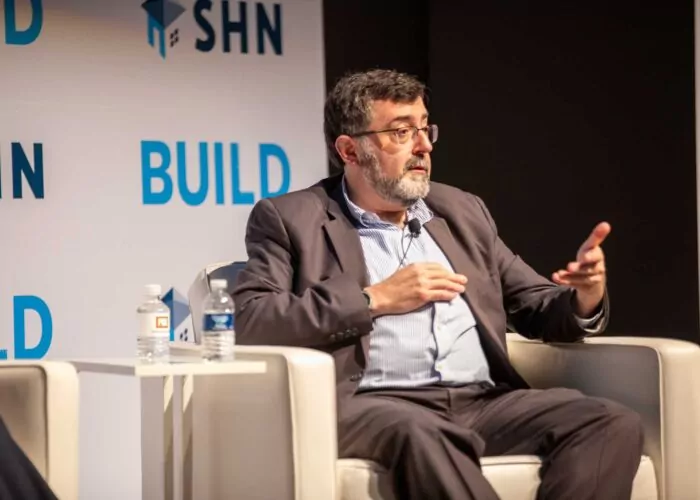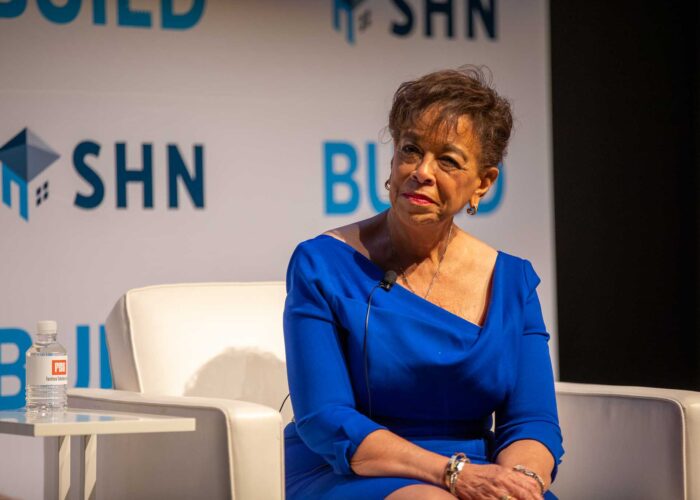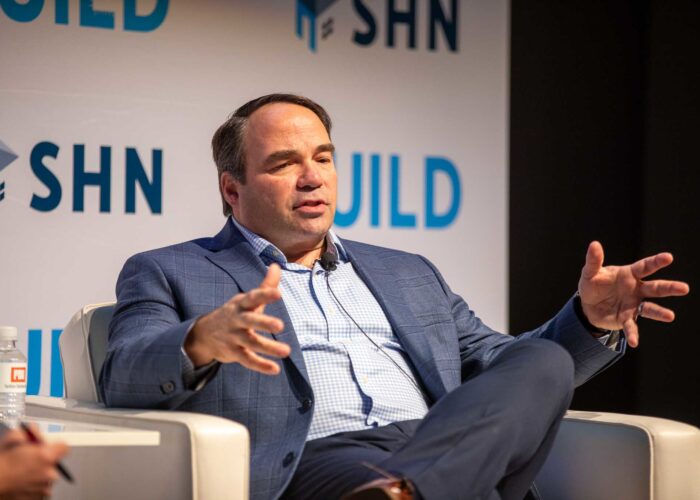At our annual BUILD event last week, The Springs Living CEO Fee Stubblefield quipped: “You guys may want to consider changing your name to HOLD instead of BUILD, with what’s going on in financial markets.”
Fee’s comment captured one message that came through strongly at the event, which is focused on senior living development and design. That message: 2023 is going to be a tough — even “awful” — year for new senior living development. And beyond next year, there are challenges and uncertainties that developers must address if they hope to be successful in the long term.
The good news is that developers and operators are formulating and starting to execute on strategies to take senior living in fresh directions and, hopefully, create long-term value.
In this week’s exclusive, members-only SHN+ Update, I share my key takeaways from our BUILD event, including:
- Why 2023 is shaping up to be such a hard year for development
- What longer-term issues are complicating development
- How operators, developers are trying to meet challenges, create long-term value
An awful forecast
Richard Ackerman, managing partner of developer Big Rock Partners, was the most blunt about the difficulties he anticipates in the year ahead.
“I think it’s going to be awful,” he said at BUILD. “At this stage … I think development’s off the table for ‘23, between no profitability in the existing portfolio, construction costs, lack of labor, regulatory [issues].”
Big Rock recently tried to secure permanent financing for the firm’s high-end life plan community project on Kiawah Island, South Carolina, and found “the market is shot,” Ackerman said. Not only have interest rates doubled in the last 60 days, but he said that uncertainty over inflation and Federal Reserve policy has “everybody concerned.”
“And uncertainty brings one thing, people put their hands in the pockets, they don’t do anything,” he said.
Ackerman was not alone in expressing a bearish outlook.
“It’s really a double-whammy that we’re seeing, between construction costs and interest rates, and it just makes it very difficult to steer your projects to a successful landing,” said David Block, director of development at Evergreen Real Estate Group.
Ryan Companies has a large development pipeline, but EVP of Senior Living Julie Ferguson was cautious about what 2023 will bring.
“We do have a lot of deals in the pipeline — we’ll see if the economy cooperates with us on being able to get all of those out of the ground,” she said.
The pace of inflation might moderate to 6% for next year and perhaps 4% in the following two years, but a shortage of construction labor is a long-term problem and will keep costs elevated, said Larry Graeve, senior vice president with construction firm The Weitz Company.
“[Subcontractors] have really strong backlogs, and it’s going to take 9 to 12 months for that to burn off to where, if they run out of work, obviously, they’re going to get hungry, they’re going to sharpen their pencils, they’re going to lower their fees, and then you’ll see some relief there — but that’s a ways down the road,” he said.
Complications further ahead
While inflation eventually will ease and the interest rate environment will become friendlier, conversations at BUILD also highlighted some thorny problems that developers and operators will need to solve.
Climate-related threats are looming large and already deterring investment.
“The project I was doing in Kiawah was originally with a very large pension plan; they backed out of it because of climate change,” Ackerman said. “ … It’s a beach resort in South Carolina. They walked, and they’ve walked from many coastal cities.”
The Springs’ Stubblefield highlighted the climate issues in the retirement hotspot of Phoenix.
“Anybody seen the Colorado River lately?” he said. “Folks, we’ve got a problem coming.”
The average flow of the Colorado River has declined nearly 20% since 2000, creating a water crisis that is projected to worsen in the coming years, as reported by Nature and many other news outlets.
Climate issues are especially pressing for senior living given the migration patterns of older adults. They continue to favor markets such as Florida, Arizona and Texas that have notable climate vulnerabilities, ProMatura VP of Market Analysis and Business Development Bryon Cohron noted.
He believes that climate change currently is not “as big a factor as it’s going to be” in driving development decisions. Ryan Co.’s Ferguson agreed. Noting that “demand underlies everything,” she said that climate threats have not yet disqualified any projects, but mitigating such threats is costly.
Availability of senior living workers is another issue that will persist beyond 2023. The issue is pressing for The Springs Living, which operates in rural and resort areas.
“Good luck hiring anybody in Bozeman, Montana, especially during the ski season, when you’ve got the Yellowstone Club and you’ve got Big Sky Resort [hiring] … It’s really, really challenging,” Stubblefield said.
As with climate considerations, Ferguson said that labor availability has not yet scuttled any Ryan Co. projects but is weighing on pro formas.
“How much do we need to assume we might need to be paying higher wage rates, or we might need to have economic incentives for people to come work for us, or because we are in a hard to reach location are we providing gas incentives or car stipends for people to make it easier or entice them to come work at those places?” she said.
Ferguson anticipates that a “tipping point” might come, when consumer demand no longer outweighs the costs of attracting workers or the risks of extreme climate events.
New approaches take shape
Despite all these issues, the mood at BUILD was not entirely downbeat. Another theme was that operators and developers are taking a long-term view, trying to find ways to meet current and future challenges.
For example, Big Rock did succeed in building the Kiawah community, and Ackerman still is not deterred from building on the coast, with steps to harden infrastructure against climate threats. The Kiawah community was built using concrete tilt-up, with strapped-down roofs, hurricane glass and generators. In the future, senior living design and construction practices will change in response to climate-related perils and related costs will have to be baked into pro formas. Even in the Midwest, tornadoes and flooding have basically spelled the end of stick-built senior living, in Ackerman’s view.
The Springs Living built its first community 26 years ago and has never sold a building, Stubblefield noted. He’s thinking about how to build today for a similarly long hold.
As one example, he said it’s only a matter of time before systems are capturing shower water for use in sinks and toilets.
“We’re going to get to that level, and so we’ve got to think through that, that impacts our long-term value,” he said. “It’s hard to make that pencil today, but there are things that are happening — FitWel is a great way to get started on that, and we’ve got to start somewhere.”
Earlier in 2022, The Springs Living was the first company to earn Fitwel global health certification under a senior living-specific scorecard.
With regard to labor challenges, The Springs Living is planning to build workforce housing on-site at one of its campuses. The workforce housing will be created as part of a 55-and-older project, given that 10% of units can be rented to younger people.
“We think that it adds value, and we’re going to try it,” Stubblefield said.
Discovery Senior Living is also looking to shake up standard labor practices as part of a long-term strategy to address “failing paradigms,” CEO Richard Hutchinson said at BUILD.
Among other labor issues, Hutchinson spoke about executive director compensation and incentives.
“They’re a business unit CEO; I’ve heard that for two decades … I’ve heard that forever, but then we compensate them with base pay and a bonus,” he said.
Discovery and the provider’s capital partners are committed over the next few years to awarding executive directors based on value creation, in a model “more akin to ownership,” Hutchinson said.
Sunrise Senior Living is another operator focused on the long-term, with CEO Jack Callison unveiling the company’s new vision statement — one to guide the provider’s “next 40 years” — at BUILD. The company’s latest development projects, including two in Manhattan, are on the leading edge of making good on that vision.
Benchmark and Brandywine also are thinking about the next iteration of senior living, and in somewhat similar fashion to each other. Brandywine CEO Brenda Bacon spoke about building senior living communities that are more organically woven into the fabric of a neighborhood, fostering “spontaneous” intergenerational interactions. Benchmark CEO Tom Grape described a similar vision of making senior living more “invisible” by weaving properties into the larger community and continuing the trend of dropping the word “senior” from branding on buildings.
So, despite expectations for a terrible 2023, optimism was palpable at BUILD — as was urgency to figure out ways of moving projects forward, to bring the next generation of senior living communities to market. Current stock is largely decades-old, Ackerman emphasized.
“I think the future is going to be in new construction,” he said.
Companies featured in this article:
Benchmark, Big Rock Partners, Brandywine Living, Discovery Senior Living, ProMatura, Ryan Companies, Sunrise Senior Living, The Springs Living, The Weitz Company








